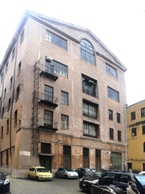Teatro dell'opera di Roma Scenic Shops
Clemente Busiri Vici
Via dei Cerchi 16, | |
| show on the map |
People
History
Original Name: Società dei Molini e Pastificio Pantanella
Original Purpose: pasta factory and warehouse
Date of construction: the industrial complex was constructed in 1878–1881, the factory building at the start of the 20th century
Style: early 20th century industrial architecture, a pioneering use of concrete trusses in Italy
Restructuring: after 1930, part of the complex served as Rome’s ethnographic museum and was later on converted to office buildings used by municipal authorities; the industrial building in the rear part of the complex has served as Teatro dell'opera di Roma scenic shops since 1939
Date of restructuring: approx. 1990s
Current use: Teatro dell'opera di Roma scenic shops
Formerly a complex of Pantanella pasta factory and warehouse buildings located right next to the church of Santa Maria in Cosmedin (which boasts of the ancient sculpture known as Mouth of Truth – Bocca della Verità) and Circus Maximus, it nowadays hosts Teatro dell'opera di Roma scenery shops. The pasta plant and warehouses were built in 1878–1881. The warehouse building was constructed in the 1930s by Italian architect Clemente Busiri Vici (1887–1965) and has served as Teatro dell'opera di Roma workshops since 1939. In 2010, plans were approved to convert the factory buildings to the Museum of the City of Rome.
The warehouse building is accessible both from the street that runs along the Circus Maximus and by an entrance way cutting across a small courtyard neighbouring the church. The five-storey factory building with its ground plan of 23 x 44 m was one of the earliest attempts in Italy to construct an industrial building with roofing that uses ferroconcrete trusses.
In the roof space there is a grand paintshop with a steel walkway and wooden floor, illuminated from all sides. Paints are blended in an adjacent room. As a rule, the paintshop uses exclusively organic powder paints.
The building has a partially flat roof that offers an outlook to all sides and is occasionally also used for scenery painting. In fact, this is the place where sceneries were painted to designs for instance of De Chirico, Picasso and other famous artists. The building hosts a thermoforming workshop below the paintshop and a large carpenter shop, locksmith shop and depot of materials on the ground floor. A crane that is used to transfer sceneries from all floors onto trucks is attached to the backyard facade with large windows. One of the floors is home to a costume shop and the theatre’s historical repository holding 60 thousand items – among them costumes designed by such designers and artists as Luigi Sapelli (aka Caramba), Giorgio de Chirico, Afro Basaldella and Alexander Calder.
The building of Teatro dell'opera di Roma scenery shops overlooks the Circus Maximus –ancient Roman venue for public entertainment and celebrations including chariot races and staging of naval battles in a huge basin, known as naumachia – and offers a great view of e.g. the Palatin and Aventin hummocks and St. Peter’s Basilica. The former pasta plant played a supporting role, if you will, in the “Roman Holiday” movie along Audrey Hepburn and Gregory Peck in the lead roles. Today, Clemente Busiri Vici’s warehouse building constitutes an integral part of the Circus Maximus complex, thus contributing to the overall genius loci of the place.
In the course of the 1931 reconstruction, a bas-relief was reportedly uncovered in the depth of 14 m, consecrated to Persian God Mithras whose cult spread to Rome and who was worshiped there in the 1st century after Christ.
Author: Marcela Steinbachová
Marcela Steinbachová:
Semperdepot, La Fenice Theatre Scenic Shops, Teatro alla Scala Theatre Scenic Shops, Teatro di San Carlo Scenic Shops, Rehearsal Stages and Admin Offices, Teatro Regio Scenic Shops in Parma, Teatro dell'opera di Roma Scenic Shops, am Wriezener Bahnhof, Französische Strasse 33D, Französische Strasse 30, Chauseestrasse 28, Zehdenicker Strasse, Newport Street, The Cut, South Bank, Purfleet, Theatre Depots and Scenic Shops, Arsenal, The Royal Provincial German Theatre scenic shop, Apolinář, Divadelní Street, Flóra, Korunní, PreslovaTranslator: Jiří Pilucha
Jiří Pilucha:
Semperdepot, La Fenice Theatre Scenic Shops, Teatro alla Scala Theatre Scenic Shops, Teatro di San Carlo Scenic Shops, Rehearsal Stages and Admin Offices, Teatro Regio Scenic Shops in Parma, Teatro dell'opera di Roma Scenic Shops, am Wriezener Bahnhof, Französische Strasse 33D, Französische Strasse 30, Chauseestrasse 28, Zehdenicker Strasse, Newport Street, The Cut, South Bank, Purfleet, Theatre Depots and Scenic Shops, Arsenal, The Royal Provincial German Theatre scenic shop, Apolinář, Divadelní Street, Flóra, Korunní, PreslovaAdditional information
No information has yet been entered
Add information




















